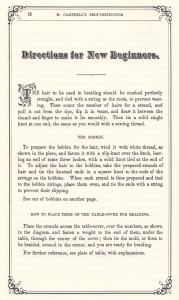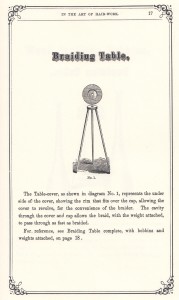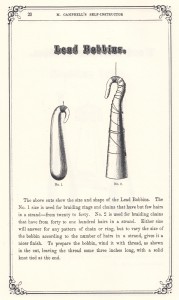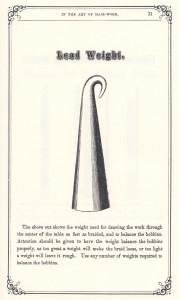Art of Hairwork 2: Directions for New Beginners
Hairworking, as a practice, was something that could be done in the home or in a proper profession. Indeed, it was one of the earliest, early-modern, female professions within an industry, as women would be employed to weave hair. Mark Campbell’s excellent ‘The Art of Hair Work’ (1875);
“THE hair to be used in braiding should be combed perfectly straight, and tied with a sting at the roots, to prevent wasting. Then count the number of hairs for a strand, and pull it out from the tips, dip it in water, and draw it between the thumb and finger to make it lie smoothly. Then tie a solid single knot at one end, the same as you would with a sewing thread.”
The methodology of hairwork is in its simplicity as a keepsake. This is a token of love that could be given to a person of affection with a simple lock of hair. Where Campbell’s instructional guide justifies the use of hair as a legitimate material for jewellery production is in how it provides a balance between this and technicality. Campbell writes in a way that makes hairworking incredibly simple for the beginner; as long as one has the instruments for its construction.
There is also an assumption based upon the weaving style that there are various difficulties in the more elaborate patterns of hairworking.
Campbell goes on to describe the bobbin next. The bobbins cut defines the braiding pattern from fine open work, to tight braiding. No. 1 can be used from one to four hairs in a strand, while No. 2 is for five to twenty.
Following on from the change in complexity of hairwork, the use of the bobbins suggests the differentiation of the difficult to the simple. Certainly, one must have skill to weave the difficult and more elaborate styles of multiple strands of hair, whereas one who could work in two to four hairs could weave simpler patterns of hair.
The essential element here is the table. The tripod table has a cap and a rim, which revolves. There is a hole through which the braid and weight can be passed through.
Here is the most important piece of the hairworking instrumentality. This table is the centre of the hairworking method; defining the outcome and providing the basis of the professional hairworking industry. With this table, the amateur hair worker could accomplish the designs that could be done within the profession of hairwork.
In this image, we can see the strands of hair over the cover with the bobbins attached and the weight attached to the braid. This enhances the weight of the hair to be passed downwards and braided into the desired shape.
These lead bobbins are for braiding rings and chains from two to forty hairs. The smaller, No 1. is used for a few strands of hair, while No 2. is for higher numbers, due to its size. Most interesting is the need to;
“prepare the bobbin, wind it with thread, as shown in the cut, leaving the thread some three inches long with a solid knot tied at the end”
Certainly, the hairworker’s craft was a delicate one; a craft which required (and still does) patience. A patience that can acknowledges the reason for importing great quantities of colour-matched hair for use in the industry. This is the reason for many sentimental jewels having greater amounts of hair than what was given to the jeweller for usage in a jewel and also for the maintaining of a proper industry that could turn over high numbers within a short period of time.
The lead weight was the counter balance to the hair working operations. It could ‘draw the world through the center of the table as fast as braided, and to balance the bobbins’, which would essentially change the braid from being loose, light or rough. Weights could be added as desired.
Such was the profession of the hairworking industry in London, that advertisements of competing hairworkers were common. This alludes to any contemporary fashion rivalry in the media and gives us a great insight as to Campbell’s demystification of hair weaving in the 1870s:
“Hair jewellery, Artist in Hair. Dewdney begs to inform Ladies or Gentlemen that he beautifully makes, and elegantly mounts in gold, Hair Bracelets, Chains, Brooches, Rings, Pins, Studs, etc. and forwards the same, at about one-half the usual charge. A beautiful collection of specimens handsomely mounted kept for inspection. An illustrated book sent free. Dewdney, 172 Fenchurch St. London.” (Advertisement, Illustrated London News, May 1862).
These are the forms for braiding over, which would define tight to open weave braids. For collectors, you may find hairwork jewels with the form showing out from frayed hair. This happens most of all around the clasp and the fittings; you will often find the interior being exposed to these jewels and accessories. It doesn’t make a great deal of impact to their sentimental value, but from a collecting standpoint, these jewels are not repairable in a way which wouldn’t compromise their original construction.
Be sure that your hairwork is protected and kept out of the light and moisture. Discolouration of hair, as well as the very susceptible nature of hair to grow mould are very common within antique hairwork worn today. Bacteria grows within the weave strands quite easily and can spread to other jewels if stored together, so do be careful if you choose to wear your jewel. Many of the style were worn over clothing, as opposed to against the skin, which can equate to why mistakes have been made today (as necklaces are more commonly worn under the clothing) and treatment of the hair isn’t proof that it won’t contract any mould.
And it is the weave that defines. As seen in the previous article, there is a great correlation towards how we can identify a jewel. Often, many have been appropriated for other reasons, the most common of which being a fob chain turned into a necklace.
Bracelets have much more different and open weaves, so they are easier to spot. Elasticity is important for stretching over a wrist (more important in the latter 19th century due to fashion), but it is necessary to analyse the jewel to be sure of its intent.
The most obvious things to look out for are the fittings. If there are obvious fittings in the centre for a fob chain, then it most certainly wasn’t originally a necklace, but a jewel can be worn for many purposes, so that is the prerogative of the wearer.













